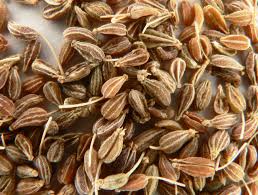Aniseed addresses stomach pain and gas, nausea

1 anise plant is a grass height of about half a meter high ribbed leg out of it long branches bear leaves, serrated round-shaped end of the branches of a small oval-shaped flowers, compressed head turns white after the maturity of the fruits of a small brown and plants live around any one year.
User segment of the plant fruits, which are described by some people as well as seed oil pilot only.
Anise plant known scientifically as Pimpinella anisum umbrella of the platoon.
Aniseed is known by several names is defined on behalf of Lincoln and taken him and cumin In Morocco they call the sweet bean sweet in Sham forget.
The original home of anise: it is said that his homeland is not known, but most of the references suggest his native Egypt, where archeologists have found the fruits of anise in the tombs of the Eastern Desert to the city of Thebes, as stated in the manuscripts Aniseed Pharaonic within several prescriptions but today it is cultivated widely in the Southern Europe, Turkey, Iran, China, India, Japan, South and Eastern United States of America.
The chemical content of anise:
Aniseed contains Zeta-pilot, the main ingredient and compound occupies Anethole principal component of the oil and Astrajul and Anaess aldehyde and Kavik derivatives Kloroujenk lion and a lion. It also contains the most important is Flavobdhirat Abjnin and fatty oils.
Aniseed and traditional medicine:
Anise plant ancient Egyptian took place therapeutically important when the pharaohs and is still widely grown today in the governorates of Upper Egypt. He came boiled seeds of anise in the Pharaonic Papyrus Ebbers syrups for the treatment of pain, upset stomach, difficulty in urine, according to the Hearst Papyrus Aniseed repelling winds and the ancient Egyptians used aromatic stimulant, diaphoretic jet swelling against the expulsion of intestinal gas as well as within the mouth wash and treat the pain of the gums and teeth.
Hippocrates was the elder, doctors, recommending that the plant is to rid the respiratory mucus, either contemporary Hippocrates Theofrast was more romantic, it was said: "If you put one near his bed Aniseed night will see beautiful dreams, thanks to the perfume of fresh" was the old Blaine nature Roman recommends chewing anise seeds fresh to moisturize and revive the soul and to help digestion after heavy meals.
John Gerrard, the world of herbs old British recommending that the anise to prevent hiccups (Alhazoukp or hiccups), as well as the description of this plant to milk yield in lactating women and treatment for cases of water retention and headaches, asthma, bronchitis, insomnia and nausea. The anise plant killer of lice and reduced for colic in infants and healing of cholera and even cancer.
In the United States during the nineteenth century, doctors had recommend addressing Alantqaiion Aniseed to ease stomach pains, nausea, intestinal gas and colic baby.
In Central America, the nursing drank milk yield of anise, and anise commodity trade is very important in all countries of the Mediterranean to the extent that the old was used Kalamlp asked to pay the taxes
Aniseed has reached a high degree of popularity as Tabla, medicine and perfume in the UK in the medieval period so that King Edward I imposed a tax to repair London Bridge.
0 commentaires